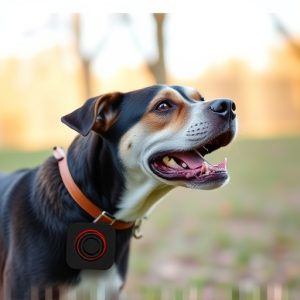Personal Protection: Navigating Aggressive Dogs with Sonic Repellents & Beyond
Aggressive dog behavior can be prevented through understanding its root causes, such as fear or inad…….
Aggressive dog behavior can be prevented through understanding its root causes, such as fear or inadequate socialization. Recognizing body language cues is vital for personal safety. Sonic repelents, using high-pitched sounds beyond human hearing, are an effective and non-lethal tool for protection, with adjustable training levels tailored to specific needs. Starting with basic commands and gradually increasing difficulty ensures manageable progress. Creating a safe space through physical barriers, environment modifications, and calm routines further reduces risks. Regularly reviewing and adjusting sonic repellent levels maintains their effectiveness against adapting dogs.
Personal safety around aggressive dogs is paramount. This comprehensive guide explores effective strategies to protect yourself from unexpected attacks. We delve into understanding canine aggression, recognizing warning signs, and the role of sonic repellents in deterring unwanted behavior.
Learn how adjusting training levels can empower you to manage comfort zones, and discover the power of creating safe spaces through environmental modifications. Explore alternative approaches beyond traditional training for long-term safety.
- Understanding Aggressive Dog Behavior: Recognizing Red Flags
- The Role of Sonic Repellents: How They Work and Their Effectiveness
- Adjusting Training Levels: Tailoring the Approach to Your Comfort Zone
- Creating a Safe Space: Implementing Physical Barriers and Environment Modifications
- Alternative Strategies: Beyond Training, Ensuring Long-Term Safety
Understanding Aggressive Dog Behavior: Recognizing Red Flags
Aggressive dog behavior can often be traced back to fear, anxiety, or a lack of proper socialization. Understanding what triggers these reactions is crucial for personal protection. When encountering a potentially aggressive dog, pay close attention to its body language and vocalizations. Signs like bared teeth, growling, elevated ears, or a rigid stance are clear red flags indicating the dog may be about to lash out.
Adjusting the sonic repellent training levels can be an effective way to manage such situations. By recognizing these early cues and implementing appropriate countermeasures, individuals can reduce the risk of being bitten or attacked. Training should focus on desensitizing dogs to various stimuli while teaching them alternative behaviors to express discomfort or fear without resorting to aggression.
The Role of Sonic Repellents: How They Work and Their Effectiveness
Sonic repellents have emerged as a popular and effective tool for personal protection against aggressive dogs. These devices use high-pitched sounds, often beyond human hearing range, to deter dogs without causing harm. The principle behind their effectiveness lies in the dog’s sensitivity to certain frequencies. When activated, sonic repelents emit a sound that disrupts a dog’s communication and orientation, causing it to feel discomfort or even fear. This reaction can be particularly powerful for dogs with a history of aggression or those triggered by specific sounds or scents.
Adjusting the sonic repellent training levels is crucial for optimal effectiveness. Users can typically set the sensitivity and intensity of the sound emitted based on their needs and the environment. Lower settings might be suitable for general deterrence, while higher levels can be employed in high-risk scenarios or for dogs with stronger reactions to sounds. Regular testing and adjustments ensure that the repellent remains effective over time as dogs may adapt to constant exposure. This feature makes sonic repelents a versatile tool for personal safety, especially when combined with traditional training methods for dog behavior modification.
Adjusting Training Levels: Tailoring the Approach to Your Comfort Zone
When it comes to personal protection from aggressive dogs, adjusting your training levels is crucial. Tailoring your approach to your comfort zone ensures effective and sustainable progress in managing potential threats. This means starting with basic obedience commands and gradually increasing difficulty as you build trust and confidence. By doing so, you can seamlessly transition from everyday walking to more challenging scenarios without overwhelming yourself or the dog.
Sonic repellent training is a versatile tool that adapts to these changing needs. Adjusting its usage based on your comfort level allows for a dynamic training experience. For instance, beginning with lower-pitched tones for mild distractions and progressively moving to higher frequencies as you face more aggressive situations. This personalized approach not only enhances your safety but also fosters a stronger bond between you and the dog, making it an invaluable asset in navigating challenging encounters.
Creating a Safe Space: Implementing Physical Barriers and Environment Modifications
Creating a safe space is an essential step in personal protection from aggressive dogs. Implementing physical barriers and environment modifications can significantly reduce potential risks. Fences, gates, and secure doors are fundamental tools to keep dogs confined within specific areas. Additionally, modifying environments involves removing enticing factors like food or toys that might provoke aggression. Creating a calm and controlled atmosphere helps establish a routine that signals safety for both humans and animals.
Adjusting sonic repellent training levels is another strategy worth considering. These devices emit high-frequency sounds that are unpleasant to dogs but often inaudible to humans. By setting the correct training level, you can discourage aggressive behavior without causing harm or discomfort. Regularly reviewing and adjusting these settings based on your dog’s behavior and environment ensures optimal protection and well-being for everyone involved.
Alternative Strategies: Beyond Training, Ensuring Long-Term Safety
When considering personal protection from aggressive dogs, it’s essential to look beyond traditional training methods and explore alternative strategies for long-term safety. Beyond basic obedience training, adjusting sonic repellent training levels can be an effective, non-lethal approach to deterring potential threats. These devices emit high-frequency sounds that are unpleasant to dogs, encouraging them to stay away without causing harm.
By integrating such technologies with consistent behavior modification techniques, individuals can enhance their safety and reduce the likelihood of dog-related incidents. Regularly reviewing and adjusting sonic repellent training levels based on a dog’s response is crucial. This dynamic approach ensures that the training remains effective as dogs, like any creature, may adapt to constant stimuli over time.
In summary, personal protection against aggressive dogs involves a multi-faceted approach. By understanding and recognizing aggressive behavior, utilizing sonic repelents effectively, adjusting training levels according to individual comfort zones, creating safe spaces through environmental modifications, and exploring alternative strategies, individuals can enhance their safety and enjoy more secure interactions with canines. Adjusting sonic repellent training levels, in particular, offers a humane and efficient solution for managing potential threats, ensuring long-term safety for everyone.


